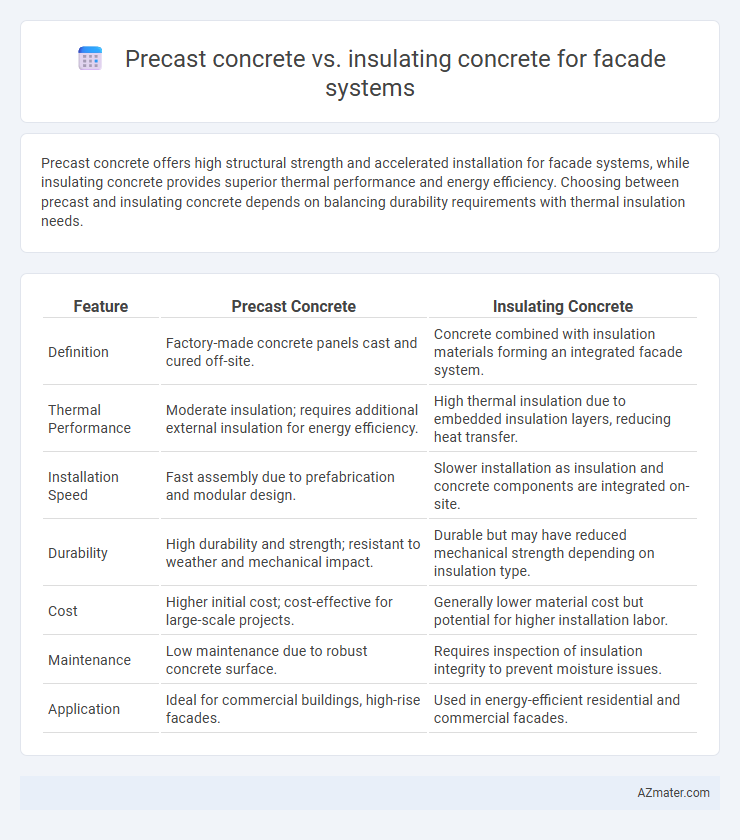Precast concrete offers high structural strength and accelerated installation for facade systems, while insulating concrete provides superior thermal performance and energy efficiency. Choosing between precast and insulating concrete depends on balancing durability requirements with thermal insulation needs.
Table of Comparison
| Feature | Precast Concrete | Insulating Concrete |
|---|---|---|
| Definition | Factory-made concrete panels cast and cured off-site. | Concrete combined with insulation materials forming an integrated facade system. |
| Thermal Performance | Moderate insulation; requires additional external insulation for energy efficiency. | High thermal insulation due to embedded insulation layers, reducing heat transfer. |
| Installation Speed | Fast assembly due to prefabrication and modular design. | Slower installation as insulation and concrete components are integrated on-site. |
| Durability | High durability and strength; resistant to weather and mechanical impact. | Durable but may have reduced mechanical strength depending on insulation type. |
| Cost | Higher initial cost; cost-effective for large-scale projects. | Generally lower material cost but potential for higher installation labor. |
| Maintenance | Low maintenance due to robust concrete surface. | Requires inspection of insulation integrity to prevent moisture issues. |
| Application | Ideal for commercial buildings, high-rise facades. | Used in energy-efficient residential and commercial facades. |
Introduction to Facade Systems
Precast concrete facade systems offer durable, factory-controlled panels that ensure high quality and rapid installation, enhancing building envelope efficiency. Insulating concrete forms (ICFs) integrate rigid insulation within the concrete, providing superior thermal performance and airtightness for facade applications. Both systems address structural integrity and energy efficiency, influencing the overall sustainability and aesthetic of modern building envelopes.
Overview of Precast Concrete Facades
Precast concrete facades consist of factory-produced panels that offer high durability, precise dimensional control, and fast on-site installation, making them ideal for complex architectural designs and large-scale projects. These panels provide excellent thermal mass, fire resistance, and sound insulation properties, contributing to energy-efficient building envelopes. Compared to insulating concrete, they typically require additional insulation layers to meet modern energy codes but deliver superior structural performance and aesthetic versatility.
Overview of Insulating Concrete Facades
Insulating concrete facades integrate rigid foam insulation within concrete panels to enhance thermal performance and energy efficiency in building envelopes. These systems reduce thermal bridges and improve airtightness compared to traditional precast concrete, contributing to lower heating and cooling costs. Their lightweight nature and ease of installation make insulating concrete facades a preferred choice for modern sustainable construction projects.
Thermal Performance Comparison
Precast concrete facade systems offer moderate thermal mass with limited insulation properties, necessitating additional insulation layers to achieve higher energy efficiency. Insulating concrete forms (ICFs) integrate rigid foam insulation within the concrete, significantly enhancing thermal resistance and reducing heat transfer through the facade. The superior R-values of ICF facades contribute to lower heating and cooling loads, making them more effective for maintaining consistent indoor temperatures compared to traditional precast concrete panels.
Structural Strength and Durability
Precast concrete offers high structural strength and excellent durability due to its controlled manufacturing process, dense composition, and resistance to weathering, making it ideal for load-bearing facade systems. Insulating concrete forms (ICFs) incorporate a foam insulation layer that provides moderate structural strength but superior thermal performance, enhancing energy efficiency while maintaining durability through reinforced concrete cores. Both systems demonstrate longevity, but precast concrete is typically preferred for applications demanding higher load resistance and robust structural integrity.
Design Flexibility and Aesthetics
Precast concrete offers high design flexibility through customizable molds and finishes, enabling intricate facade patterns and textures that enhance architectural aesthetics. Insulating concrete forms (ICFs) integrate insulation within the concrete structure, optimizing energy efficiency while allowing smooth, uniform surfaces suited for modern minimalist facades. Both options support diverse aesthetic choices, but precast concrete excels in detailed, decorative applications, whereas insulating concrete emphasizes streamlined, energy-efficient facade designs.
Installation Speed and Construction Process
Precast concrete facade systems offer faster installation due to factory-controlled production and modular assembly, enabling rapid on-site placement and reduced labor time. Insulating concrete forms (ICFs) require a more labor-intensive process with on-site pouring and curing, which extends construction timelines but improves thermal performance by integrating insulation directly into the wall structure. The streamlined installation of precast panels minimizes weather delays and site congestion, providing a more efficient construction process in time-sensitive projects.
Cost Efficiency and Lifecycle Analysis
Precast concrete offers cost efficiency through reduced labor and faster installation, minimizing on-site construction time and associated expenses. Insulating concrete systems enhance lifecycle performance by integrating thermal insulation within the structure, leading to significant long-term energy savings and reduced maintenance costs. Lifecycle analysis reveals that while precast provides upfront economic advantages, insulating concrete's energy efficiency contributes to superior total cost of ownership over the building's lifespan.
Sustainability and Environmental Impact
Precast concrete facade systems offer high durability, reducing maintenance frequency and waste, while their factory-controlled production minimizes material runoff and energy consumption. Insulating concrete forms (ICFs) significantly enhance building energy efficiency through superior thermal insulation, lowering heating and cooling demands and reducing carbon emissions over the building's lifecycle. Choosing between precast and insulating concrete facades depends on balancing upfront environmental costs with long-term energy savings and sustainability goals.
Choosing the Right Facade System: Key Considerations
Precast concrete panels offer advantages such as high durability, fast installation, and design versatility, making them suitable for projects requiring strong structural performance and aesthetic customization. Insulating concrete forms (ICFs) provide superior thermal insulation and energy efficiency, reducing heating and cooling costs while enhancing building envelope performance. When choosing the right facade system, consider factors like thermal requirements, structural load, project timeline, budget constraints, and local climate conditions to optimize both performance and cost-effectiveness.

Infographic: Precast concrete vs Insulating concrete for Facade system
 azmater.com
azmater.com